|
|
Hackler

|
|
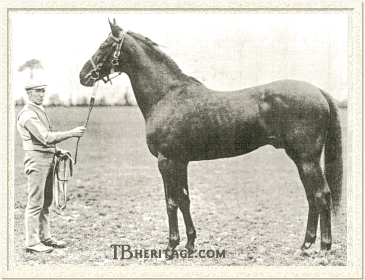 |
|
|
English-bred Hackler, a modest winner on the flat, became a very successful and versatile sire of brilliant juveniles, solid mid-distance flat racers, and top steeplechasers as a stallion at Hartstown Stud in Ireland. He led the sire's list in Ireland for flat racers, either in terms of money won or number of winners between 1898 and 1904, and was a leading sire of jumpers in the U.K. for seven years. He was also a good broodmare sire of successful flat runners in England and Ireland.
Hackler's sire, Petrarch, was a good racehorse, and by all reports exceptionally attractive. He was by St. Leger winner Lord Clifden, and out of Laura, who was bred at Hampton Court Paddocks by Lord Greville and was by Orlando, who was the principal stallion lodged there. Laura was a modest runner in the sprinter mode, winner of York's Zetland Stakes and second in Pontefract's Park Hill Stakes at age two, and at age three winner of the half-mile March Stakes at Goodwood. In the stud of Mr. Gosden at Midhurst she bred six winners, including Petrarch, Lemnos, a winner of eleven races at ages two and three, and Laureate, who won Newmarket's Craven Stakes, a Stockbridge Biennial and Goodwood's Singleton Stakes.
Petrarch easily won the Middle Park Plate as a juvenile by four lengths, and at age three won the Two Thousand Guineas, Ascot's Prince of Wales's Stakes, and the Doncaster St. Leger, although he ran unplaced in the Derby Stakes (won by five lengths by Kisber in a canter), a showing that baffled and upset the public and turf observers, especially after he proved to be an excellent, if erratic, stayer in later races. At age four his big win was the 2 -1/2 mile Ascot Gold Cup and two other races, and he was second, giving away 18 pounds, in the Liverpool Summer Cup, but he was unplaced in the Goodwood Cup. At age five he won Ascot's Rous Memorial Stakes, but was not placed in two other races.
Petrarch raced for Lord Dupplin and was trained by John Dawson until his St. Leger win, when he was sold to Lord Lonsdale. When he was retired to stud, he was sold to Lord Calthorpe and was installed at the Hampton Court stud in 1879, but spent some of his years at stud at Lanwades Stud at Kennett, near Newmarket. As a stallion he got three classic winning daughters: Throstle (St. Leger), Busybody (One Thousand Guineas and Oaks), and Miss Jummy (One Thousand Guineas and Oaks), and a son, The Bard, undefeated in sixteen races as a juvenile. Many of his youngsters were early maturers, and in all he got winners of 254 races in his sixteen years at stud; he was fourth in 1885 and 1886 on the leading sire's list. His sire sons were not very successful, with The Bard, Lemnos, and Laureate getting few good winners. Of all his offspring, Hackler was by far the most successful in the stud.
|
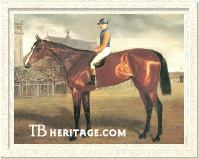
Hackness
| |
Hackler's dam, Hackness (1878), was out of Cicily Hacket (1869) by Le Marechal. Her sire was the stayer Albert Victor, by July Stakes winner Marsyas; Albert Victor was the winner of the Middle Park Plate, the Ascot Gold Vase and York's Ebor Handicap. Her dam, Cecily Hacket, produced several other daughters that bred on: one, Lina Hacket (1887, by Hermit), produced Lorlot, a winner of some good races in France, and another, The Bat (1885, also by Hermit), became tail-female ancestress of a host of good stakes winners, notably the French-bred offspring of the excellent producer and Prix de Conde winner Rose O'Lynn (1944).
|
Hackness was bred by T.W. Deighton, and ran as a juvenile in the ownership of Mr. Foy, winning two races in seven starts -- the Kempton Park March Two-Year-Old Plate, and a selling sweepstakes at Newmarket -- after which she was sold to T. Brown for 520 guineas. She did not run at age three, and during that time was sold to Robert Peck, who had trained Derby winners Doncaster and Bend Or and Oaks and St. Leger winner Marie Stuart, but by that time had retired as a breeder and owner to Howbury Hall, Bedfordshire.
For Peck, and trained by James Hopper, she started again at age four, winning a hunter's flat race at Sandown Park. Peck, a successful gambler, won a great deal of money with her when she won Newmarket's Cambridgeshire (1 mile-1 furlong) in the fall, carrying the light weight of 6 st.-4 lb. At age five she ran seven times, her best race a good second, a length behind Don Juan in the Cesarewitch (2 miles-2 furlongs) that year; she had shown that she had both speed and staying ability. Peck also owned the great Irish stayer, Barcaldine, and co-owned the brilliant juvenile by Petrarch, The Bard.
Hackness was retired to Howbury, where, in 1886 she dropped a filly by Skylark (sire of 1896 Grand National winner The Soarer). Her next two foals -- Hackler (1887) and Pauline (1888, by Peter) were purchased by the Scottish-born heir of two fortunes, George A. Baird ("Mr. Abington" on the turf), a competent amateur rider and notorious in British social circles for the raffish company he kept and for his tempestuous affair with the famous actress Lily Langtry. Baird won the Epsom Derby with Merry Hampton in 1887, the year Hackler was born, and had also won the two classic fillies' races of 1884 with Petrarch's daughter, Busybody. He would also breed the unbeaten juvenile, Meddler (1890, later twice leading sire in the U.S.), by Petrarch, who did not run in the classics because his nomination was voided by Baird's death in 1893.
After dropping Hackler and Pauline, Hackness was sold to Sir John B. Maple and spent the rest of her life at Childwick (later Childwick Bury) Stud at St. Albans, where she produced four more foals to Maple's stallions Saraband, Lord Derwent, Common, and Royal Hampton; she died in 1894.
Hackler was his dam's second, and best, foal, born in 1887. When grown, he was described as having a "grand front and action," with "straight hind legs, a nice eye and plenty of speed." He topped out at 16.1 hands, and measured nine inches below the knee, and inherited his sire's long back and neck, and some of his beauty. He was sent to Newmarket trainer Charles Morton at Bedford Lodge; Morton would later train winners of eleven classic races for J.B. Joel. Throughout his career on the turf, Hackler had the benefit of top jockeys, including Jack Watts, Sam Loates, and Tom Cannon.
Hackler on the Turf
Hackler started his career as a juvenile, placing third in his first race, the Excelsior Breeders foal plate over five furlongs at Leicester. Favored for the five furlong Dyke Plate at Newmarket in his next outing, he failed to place. Five months later he was at Newmarket in a nursery plate over five furlongs, where he ran sixth in a field of fourteen. Finally, in his fourth race, a five furlong maiden stakes at Croyden, he won by a length. He was taken to Warwick in the late fall and ran in a five furlong nursery plate, where he was second favorite, and ran unplaced. That was the end of his two year old season.
He started the next year in the Column Produce Stakes over a mile at Newmarket, and did not disappoint the betting public that had placed him favorite by winning. He ran back the very next day, in the one mile Bennington Stakes, and won again. His next race was Newmarket's Hastings Plate (one mile), where he ran third to Heaume (later winner of the Prix du Jockey Club). He went on to Kempton for the Kempton Park Handicap over six furlongs, but did not place. His last race of the season, and, as it turned out, his career, was Newmarket's Burwell Stakes over the Abingdon Mile at Newmarket in May; he won. After that race, he was basically shelved, possibly due to injury. In his career he had won three stakes races over a mile, and a maiden stakes over five furlongs, and was placed third twice.
Hackler in the Stud
In 1891 Baird sent Hackler, age four, to Newmarket's December sales; he hadn't run since his win in the Burwell Stakes the year before. He was purchased for 800 guineas by horse dealer, racehorse owner and breeder James Daly of Liffey Bank, Dublin.
As a teenager Daly had purchased remounts for the British Army during the Crimean War, and went on to become a hunter dealer based at Liffey Bank, establishing a reputation for honesty and integrity. In the early '80s, when he was forty-four, he bought Hartstown Stud near Clonsilla, Co. Dulbin, and established his own breeding farm, in addition to registering his racing colors. He continued to act as a dealer of high-class hunters and jumpers; Ascetic's good sons Cloister (Grand National) and Royal Meath (Grand Steeple-Chase de Paris), Hackler's son Jenkinstown (Grand National), and Grand National winner Why Not were some of the many that passed through his hands. He also raced a number of horses in England and Ireland, with varying degrees of modest success, but it wasn't until he purchased Hackler's yearling son ST. BRENDAN, bred by someone else, that he had a really good flat runner.
In addition to Hackler, whose stud fee was ten guineas, Scarsborough Stakes winner Atheling (sire of the good Irish juvenile Athel), Bird of Freedom, Newmarket Two Thousand Guineas winner Enthusiast (dam's sire of Irish Grand National winner Civil War and of Easter Week, the dam of Easter Hero), Springtime, Bushey Park (dam's sire of Grand National winners Vermouth and Shaun Spadah), Rapallo, Succoth and Ardoon served as stallions at Hartstown Stud at various times. But of these, Hackler was the most successful, both as a sire of flat racers and of jumpers. Hackler remained in Daly's ownership until his dealth in 1907. Daly himself died in the fall of 1917.
Hackler got winners of only five races in his first two seasons at stud. But as the nineties drew to a close, he showed himself to be a versatile sire of winners both on the flat and over fences, which ultimately included brilliant juveniles, Grand National winners, and good middle-distance handicappers that won in Ireland and England. Even though he got two Grand National winners, and many top steeplechasers, for the most part his jumping offspring could not quite stay the four miles necessary to win the National, doing better at distances around 3 miles. His flat running offspring were mostly fast juveniles and horses that did well at about a mile to a mile and a quarter; with a few exceptions, he did not get stayers like his sire and dam.
He was a dominant flat racing stallion in Ireland between 1898 and 1906, either in terms of number of races won or amount of money won by his progeny, or both, and was either first or second in the leading sires of jumpers lists in the U.K. between 1905 and 1912. He was in the list of the top twenty leading sires of broodmares in the U.K. seven times between 1912 and 1921; his highest spot was in 1915, when he was sixth, with 19 winners of 29 races worth £6,417 (over half due to his grandaughter Ayn Hali, the champion junenile in Ireland); that year he would have been second in the list behind Persimmon, had the list been based on number of winners, rather than amount won.
In his first decade as a stallion, Hackler got two Irish classic winners, SABINE QUEEN and ST. BRENDAN. In addition his first jumpers demonstrated his excellence as a sire of steeplechasers.
SABINE QUEEN (1895) was out of The Sabine, by Xenophon. As a juvenile she won the Railway Stakes for her owner, F.F. McCabe, and was co-favored for Leopardstown's five furlong Londonderry Plate with P.P. Gilpin's filly Medine. Medine won this race, and Sabine Queen was not placed--but the distance for the race had been inaccurately marked, and McCabe lodged a protest. Medine and Sabine Queen then met in a £300 match race over five furlongs in September at Baldoyle; Sabine Queen won, carrying 9st.-4 lbs., to Medine's 8 st.-8 lbs. The next year Sabine Queen won the Irish Oaks. She later produced Queen of Peace (1905), who also won the Irish Oaks and was dam of Pallas Athene, winner of good races in Austria and Hungary, whose descendants included to Hungarian St. Leger winners and other top runners in eastern Europe.
Another good juvenile filly by Hackler was HORNET (1897, out of Madge by Heart of Oak), unbeaten at age two, whose wins included Leopardstown's Zetland Plate and the Curragh's Marble Hills Stakes. In the stud Hornet bred six winners of thirty-seven races, the best by far being the famous sprinter Hornet's Beauty (1908), a winner of 31 races. Hornet's female line also bred on, and for several generations had a reputation for speed: Epsom Derby winner Teenoso, Irish Oaks winner Give Thanks (1980), and Kentucky Oaks winner Tiffany Lass (1983) were just a few of her more recent good descendants.
Hackler's son PRINCE OF NAPLES (1896) was a winner of the Waterford Testimonial Stakes, receiving nine pounds from the colt Monmouth; Monmouth had beaten him two months earlier over six furlongs at the Curragh, and a £500 match over five furlongs was arranged between the owners, to be held in October of 1898; Prince of Naples was the winner.
Most of Hackler's jumpers born in the 1890s were out of half-bred mares, many of them daughters or grandaughters of Ascetic, whose bloodlines did much to bolster Hackler's early reputation as a jumper sire.
LADY CRUICKSHANKS, a half-bred bay filly out of Violetta, by Ascetic, ran unplaced in some steeplechases, however she bred several winners over fences, including Sprinkle Me (1900, by Rapallo), a winner of nineteen chases, including the Grand Military Gold Cup twice, the Household Brigade Cup three times, and the International Handicap chase (Leopardstown Steeplechase).
JUNO (1894), out of the half-bred Flora, by Ascetic, won three steeplechases before dying early in 1903. Her brother, UPHANTES (1893) was a winner of seven steeplechases.
The half-bred ARDGREAGH (1895), out of Ethelreda, by Atheling and out of an Ascetic mare, was bred at the Carrollstown Stud at Trim, Co. Meath, of P.J. Dunne. When she was five she won three steeplechases, and at age six won two chases, including the Nottingham Handicap Steeplechase. She later bred Uncle Pat (1908), a winner on the flat of the 5 furlong Curragh Grand Prize for juveniles and three other races, and second in the Lincolnshire Handicap before his sale to Germany; Cornflower (1905), who won on the flat and over fences between the ages of four and seven; and Atty (1906), an entire colt that won six races, including the Bilbury Cup and the Lewes Handicap and was later a hunter sire, winning first prize at London in 1913. Ethelreda also produced several winners to the cover of Hackler's son, Flying Hackle, at Carrollstown.
THE HAKE (1895), out of Avisa, was a gelded Hackler son that did well over fences; he won the three mile Irish International Handicap (Leopardstown Steeplechase) at age five.
DODRAGH (1898) was a thoroughbred out of Atheling Lady, by Atheling. She was one of Hackler's winners over fences, at age four winning a maiden plate at Punchestown over four miles. In the Sledmere Stud in Yorkshire she produced five winners, including the 1918 Cambridgeshire winner Zinovia (later dam of five winners), and a number of other youngsters that sold for very good money at the yearling sales. She also bred on, with 1965 Richmond Stakes winner Berber and the multiple stakes winning U.S.-bred colt Pompoon (1934) descended from her in tail-female.
Another Hackler daughter that won over fences was the half-bred MERVILLE (1896), a winner of eight steeplechases in Ireland for her owner H. Dudgeon of Dumore. In the stud she produced several winners over fences. Hackler's daughter FANCIFUL (1895, out of Miss Fanny) won the Irish International Steeplechase (Leopardstown Steeplechase) in 1902, and also ran fifth in the Grand National of 1903. |
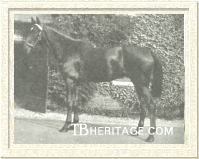
Hack Watch
| |
ORGANDALE (1899) was a half-bred bay Hackler colt out of the Ascetic mare, Katie. He won eight steeplechases in Ireland. Another half-bred Hackler son, ELAND (1900, out of steeplechase winner Antelope) won six races over hurdles.
HACK WATCH, a gelded thoroughbred son of Hackler's bred by H. Turnstall Moore, was born in 1900, out of the Aughrim daughter On the Watch. He was one of Hacker's really good jumpers, an exceptionally precocious winner of seven races at the age of five, including Liverpool's Stanley Chase and the Grand Sefton. He won the Grand Sefton a second time (the first horse to do so) the following year, 1906, carrying the big weight of 12 st.-7 lbs., but he did not run again after that race, and died in the spring of 1907.
|
Flying Hackle
Hackler's son FLYING HACKLE (1897, from the Atheling mare Lady Callert), was, like his sire, a flat racer. In Ireland he won the International Foals Stakes as a juvenile, and the Baldoyle Derby over 1-1/2 miles at age three. And, like his sire, he got both flat racers and jumpers as a stallion at Patrick Dunne's Carrollstown Stud in Trim, Co. Meath. His son, Royal Weaver, won the seven furlong National Stakes and the five furlong Autumn Handicap at the Curragh as a juvenile and four races at age four, and his brother, Royal Hackle, won the Leopardstown Plate over a mile in 1911 at age three and four races at age five. The gelded Cheery Pat won the 1910 Beresford Plate over one mile when a two-year-old. These and other youngsters pushed him into the top position as leading sire in Ireland in terms of races won in both 1911 (11 winners of 27 races) and 1912 (13 winners of 25 races; also leading money-winner). Despite this, he did not get a sire son that could continue the line.
Lodged as he was at Carrollstown, which mostly turned out hunters and steeplechasers, FLYING HACKLE got a number of winners over fences. One Carrollstown product by Flying Hackle was The Best (1905), a handsome 16.1 hands brown horse "with great power, hocks, bone and action," a winner of four King's plates and later a stallion in Ireland; his sister, Hackla (1907) won four races on the flat and was later the dam of successful steeplechasers, and his brother, Better Still, won six flat races. They were out of the aforementioned Ethelreda, a grand-daughter of Ascetic.
Another bred at Carrollstown by Flying Hackle was the half-bred Flying May (1915, out of the Ascetic daughter Little May), who became the dam of 1937 Grand National Steeplechase winner Royal Mail (1929, by My Prince). Flying May also produced ALGY A. to the cover of Hackler, who, running on the flat, won the Curragh's Madrid Handicap at age three.
Two Flying Hackle youngsters bred at Carrollstown out of the Ascetic daughter Sorrel were Wind Flower (1904), winner of eight steeplechases and four hurdle races, and his sister Chestnut Hackle (1905), who won two flat races and two steeplechases. Other winning chasers and flat racers by Flying Hackle from Carrollstown were Jim May (1905, winner of three steeplechases); Dick Bell (1907, winner of four races and a steeplechase), and Stephen (1908, winner of seven races); and Ethelfleda (1904, a winner of five hurdle races, a steeplechase, and four king's plates).
St. Brendan and Royal Hackle
The bay ST. BRENDAN (1899), was bred by E. Flannery and sold as a yearling to Daly; St. Brendan was out of Court Card by Royal Hampton, and became Hacker's best flat racing son. He, along with FLYING HACKLE, who was much the inferior runner, were the best hope to continue the Petrarch sire line, but in the stud St. Brendan was unable to live up to his promise on the turf.
Trained by Michael Dawson, his three wins as an unbeaten two-year-old included the Railway Stakes (6 furlongs). At age three he won two races, the Drogheda Memorial Plate (5 furlongs at the Curragh), and the Irish Derby (1 mile-4 furlongs) over a field of eleven where he simply outclassed the field, and then Daly took him to England, where it was anticipated he would win the Doncaster St. Leger. He finished fifth in that race, having faded badly after a mile, making it clear he was not a stayer, and was backed off in his next race, to the Curragh's seven furlong Turf Club Cup, which he won.
St. Brendan ran only once in both 1903 -- the Royal Hunt Cup (England) in which he started equal favorite and was unplaced -- and 1904, when he won the five furlong Leopardstown Grand Prize. In 1905 he was back in England for Kempton's Jubilee Stakes, failing to place. Kept in training at age six, he redeemed his reputation -- as a sprinter -- by winning the Earl Sefton's Plate at Liverpool (6 furlongs), giving Chaucer 9 pounds and beating him by two necks; and the 6 furlong Stewards' Handicap at Kempton, giving the younger, brilliant sprinter Thrush 25 pounds and beating him by a head; he also ran second in the 6 furlong Salford Borough Handicap.
Because he was considered somewhat well-bred, with Hackler such a successful stallion, and with Petrarch as a grandsire and his dam's female family including Saraband and other good runners, many thought he had a chance at continuing the sire line at Daly's Hartstown Stud, but he was only average, and did not get a sire son that continued the line. St. Brendan got winners, mostly mid-distance runners, of 87 races in his fourteen seasons at stud. His best offspring included Mellifont, the champion money winning horse in Ireland in 1902, when, as a juvenile, he won the Railway Stakes and three other races for Daly, and Our Stephen who won the Chester Cup for Frank Curzon. His sister, ST. BRENDA (1903), was the dam of four winners.
The half-bred bay ROYAL HACKLE (HB -1), was another entire Hackler son, born in 1900, out of the good winner Queen May, who bred foals in Co. Meath for the joint owners H.J. Cullen and J.C. Sullivan, both of whom had studs near Navan. He won the Leopardstown Plate over a mile, and later, at J.M. Kelly's stud in Co. Westmeath, got some good jumpers, including Spinning Queen (1906), a winner on the flat and over fences, including ten steeplechases between the ages of four and ten, among them the Metropolitian Plate; she was later a producer. Two other entire Hackler sons, GREEN HACKLE (1898, out of the half-bred Polly, by Don John), and HACKENSHMIDT (1901) got some minor winners. An entire colt of Hackler's last crop, UNCLE GEORGE (1908) got Hotspur, who was imported into the U.S., where he won the tough timber chase, the Maryland Hunt Cup.
In 1898 Hackler topped the leading sires list in Ireland for the first time, with ten youngsters winning 22 races worth £2,384; the low value reflected the nature of racing in Ireland in the 19th and early 20th centuries, where prize money lagged far behind what was offered in equivalent races in England. In 1900 he was first on the list, both in terms of money won and races won -- 17 horses winning 28 races worth £2,976. In 1902, he was at the top in terms of races and money won, tied with Gallinule for the number of runners; in 1903 and 1904 he was again at the top, in terms of number of winners, and in 1906, the year of LALLA ROOKH's juvenile season, in terms of money won. Most of his best known offspring were born after the turn of the century. |
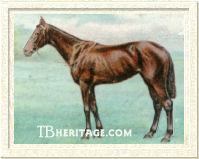
Hackler's Pride
| |
HACKLER'S PRIDE (1900) was out of Comma, by Friar Rush or Coltness. She was bred in Co. Limerick, Ireland, by Patrick Quinlan, who later named his stud there after her. Purchased as a yearling for 75 guineas at the Dublin Livestock Sales, she ran winless in Ireland, but was then purchased by John H.H. Peard for Captain Frank Forester, who became a famous Master of Hounds (for Limerick and then the Quorn); both Peard and Forester were members of the Druid's Lodge "Confederacy," a racing partnership that brought off huge gambling coups -- in which Hackler's Pride figured -- just after the turn of the twentieth century.
|
Nominally trained by Jack Fallon at Druid's Lodge, Sailsbury, Hackler's Pride won eight races, including the Cambridgeshire Stakes handicap at Newmarket two years in succession (1903 and 1904), in which the Confederacy, who carefully controlled and planned the campaigns of their horses, made a great deal of money in bets. In 1905 she won Ascot's Rous Memorial Stakes (7 furlongs).
After the Rous Memorial Stakes, HACKLER'S PRIDE was purchased by Sir Tatton Sykes for his famous Sledmere Stud in Yorkshire. There she bred six winners of modest quality, all of which brought good prices at the yearling sales, her best being Brancepeth, who won eight races worth £2,614, and Sobieski, who won two good races. Her other offspring included Torchbearer, sent to the U.S., Ionian, Free from Pride, The Gift of Gab, Thracia, and two daughters, Petite Soeur and Sunstar's Price, that bred on with stakes winning descendants. She died in 1922.
|
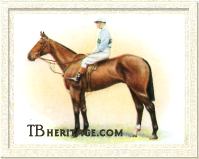
Jenkinstown
| |
JENKINSTOWN (1901) was Hackler's first Grand National winner. He was out of Playmate, by the good jumper sire Play Actor, and was bred by P. Leonard in Co. Meath, and purchased by Daly, who sent him to J.J. Maher, whose Williamstown Stables was near Hartstown, for schooling. Jenkinstown fell in his first race over fences, at Hurst Park in May of 1906. The next season he won two small chases, one at Kempton Park in December 1906 and one at Manchester in January. Early in 1908 he ran second in two steeplechases, and was then sold to Stanley Howard for £600. |
Howard had won the 1907 Grand National with Eremon, and placed Jenkinstown in training with Tom Coulthwaite at Hednesford in Saffordshire. Coulthwaite had trained Eremon for Stanley, and would win the Grand National again with Grakle in 1931.
Jenkinstown had a succession of disasters after his sale, unplaced at Birmingham, falling at Warwick, and pulled up in both Liverpool's Grand Sefton and in his first try in the Grand National (won by Rubio).
Jenkinstown wasn't seen on the turf again until late in December of 1909, when he won the Ingreste Chase at Wolverhampton. He was then easily beaten by Moonstruck at Haydock Park, and two weeks before the Grand National he had done badly in a chase at Kempton Park. In March, 1910, he won the Grand National by three lengths, very lightly weighted at 10 st.-5 lbs., with the great chaser Jerry M., carrying 12 st.-7lbs. second by three lengths. Although he ran for two more years, he never won another race, and died in 1912. Although he had the talent to win the National, it's clear from his record he had some health issues; Coulthwaite excused his two poor showing just prior to the National by saying Jenkinstown suffered from "an attack of gripes," or colic, and perhaps it was this that kept him from reaching his potential as a chaser.
Covert Hack, Covertcoat and their Family
One of Hackler's first really good steeplechasers was the gelded COVERT HACK (1894), bred by J.J. Maher, who made extensive use of Hackler as a jumper sire around the turn of the century, breeding him to two half-sisters, Cinnamon, by Concha, and Circe, by Play Actor, both bred by Maher from Mount Royal, by Monarch of the Glen. Cinnamon, the dam of Covert Hack, would later produce Hackler's second Grand National winner, COVERTCOAT, and Ballymacarney (by Ascetic's son Royal Meath), who would produce another good jumping Hackler son in BALLYHACKLE, and his half-brother Ballymacad (by Laveno), who won the wartime Grand National in 1917. Cinnamon was a good hunter that dead-heated for a £300 steeplechase at age five and was second in a steeplechase at age six before Maher retired her to the stud. Circe would breed three good chasers to the cover of Hackler -- FLAXMAN, OLD FAIRYHOUSE, and CACKLER. All these horses were bred in Ireland by Maher.
COVERT HACK was sold to Captain Eustace Loder, who had purchased the famous Eyrefield Lodge at the Curragh in 1898, from whence in the 1870s and '80s its former owner and chaser trainer H.E. Linde had sent out four Sefton Steeplechase winners and four Conyngham Cup and nine Prince of Wales's Plate winners, as well as an Irish Derby winner and five Baldoyle Derby winners. Among the many good horses Linde had trained, which included three Grand National winners, was Ascetic's son Royal Meath, winner of the Grand Steeple-Chase de Paris.
Covert Hack won Liverpool's Stanley Steeplechase and the Conyngham Cup at age five, carrying 12. st-2 lbs in the latter. At age six he ran in the Grand National, where he fell at the first fence, but riderless, he brought down the favored Hidden Mystery during the second circuit, which allowed Ambush II to win that race. Covert Hack also won the Conyngham Cup that year, 1900, and again in 1901, both times carrying 13 st.-5 lbs.; he was the only horse to win that race in successive years, and he would win it once more, in 1903.
Covert Hack's half-sister, Ballymacarney, by Royal Meath, was born in 1897. She jumped a boundary fence when nine days old, blinding herself in one eye, and never raced. She bred two very good chasers for Maher. One, the gelded bay BALLYHACKLE (1903), by Hackler, won eleven chases, including Liverpool's Grand Sefton in 1914; he ran four times in the Grand National, and was favored in 1913 (the year his near-relative COVERCOAT, by Hackler, won), but fell. The other was Ballymacad (1907, by Laveno), who won the wartime Grand National at Gatwick in 1917. A sister to BALLYHACKLE, BALLYMACOLL (1904), bred on: a tail female descendant of hers, Chez Monty (1945, by Montrose), bred in Ireland by R.J. Ball, was imported specifically into South Africa to run in the Durban Gold Cup (2 miles), which he won in 1950 and 1951.
|
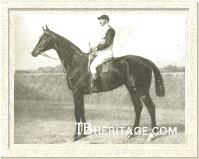
Covert Hack and his brother (below); the famous chaser rider Arthur Hughes-Onslow Up
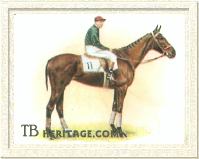
Covertcoat
| |
Covert Hack's brother, COVERTCOAT (1906), won the 1913 Grand National, Hackler's second winner of that race. Born when his dam, Cinnamon, was age twenty, he was broken by Maher's trainer Fred Quinlan at age three. He ran once for Maher, after overcoming a spavin and a bout of influenza, at age five, winning the Maiden Plate at Punchestown. Maher was beginning to disperse his jumping stable at that time, and sent Covertcoat to the Dublin sales in the summer of 1911, where he was purchased for 1,075 guineas by Sir Charles Assheton-Smith (owner of Grand National winners Cloister and Jerry M.).
COVERCOAT, trained at Findon by Robert Gore for Assheton-Smith, won the Park Trial Handicap Chase and then the 1913 Grand National, a 100 - 9 longshot and one of only three that finished that race, "after a series of melancholy accidents," in 22 starters. When he traveled back to Findon, via rail, he was met at the station by his stablemate, Jerry M., and an excited crowd, who escorted him back to Gore's stables, a laurel wreath draped over his withers. When Assheton-Smith died in 1914, his wife sold Covertcoat to Sir Robert Duff (Assheton-Smith's brother); Duff died in World War I a few weeks after purchasing Covertcoat, and the horse was sold to Eric Platt, for whom he won one race, the Marsh Green Steeplechase at Lingfield, in April, 1916. In his next outing, the Conyngham Cup of 1916, for which he was favorite, he fell at a double bank and broke his neck. His hooves were made into ink stands and displayed at Gore's Downs House in Findon. |
|
Cinnamon had several other foals by Hackler, including BROWN HACKLE, "a small filly but a wonderful jumper" won some small races in Ireland and then was sold to Germany and BALLYHACK was sold to the Duke of Westminster, but broke his leg in his first race in England.
|
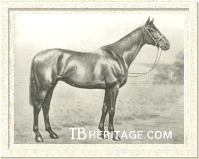
Cackler and his brother (below)

Old Fairyhouse
| |
The other branch of this Mount Royal family, descended from Cinnamon's half-sister, the Play Actor daughter, Circe, who bred three good jumpers by Hackler. FLAXMAN (1900), owned by King Edward VII, won some chases and was fourth in the 1908 Grand National. CACKLER (1903), an entire, had a short, but brilliant career; he was very good up to three miles, and an excellent jumper that "never touched a twig." He was raced by Maher, winning four of his six races at age four, including the Valentine Steeplechase at Liverpool, and placing second in the other two. He was purchased by trainer Robert Gore for Sir Charles Assheton-Smith -- who was on the hunt for a National horse -- early in 1908, and that year was unbeaten, winning Sandown Park's Burwood Steeplechase over three miles, a race at Newbury, and the Champion and Valentine (again) Steeplechases at Liverpool. He was entered in the 1910 Grand National (won by Hackler's son JENKINSTOWN), but fell lame before the race and was scratched. The next year he won the Trial Handicap chase at Hurst Park and then ran third in the Liverpool Trial Steeplechase over 3-1/2 miles at Sandown Park, three weeks before the 1911 Grand National. Gore and Assheton-Smith disagreed regarding Cackler's ability to stay the Grand National course, and consequently Cackler was tried against the good chaser Mount Prospect's Fortune at Sandown to determine if he should run; Cackler pulled up lame after the trial. It proved to be a longitudinal fraction of his cannon bone, and that was it for him.
|
The third Circe son by Hackler was OLD FAIRYHOUSE, a dark bay/brown gelding (1902). He was purchased by the amateur rider Calverley Bewicke. He ran second in three successive races: Liverpool's Champion chase (to Mount Fortune's Prospect); Hereford's Coronation Steeplechase (to Wedding Day), and the Northumberland National Steeplechase (to Lawyer II). His big win was the Grand Military Gold Cup at Sandown, ridden by his owner.
DISTAFF, a sister to Old Fairyhouse and Cackler, was a small mare. At age six she won the 1914 Grand Sefton Steeplechase for Sir George Bullough, beating the three-time Scottish Grand National winner Couvrefeu II, and the aging 1909 Grand National winner Lutteur III.
Other Hackler Winners
One of Hackler's most spectacular flat runners was the 1904 filly LALLA ROOKH, out of Lady Gough by Lord Gough, bred and raced by Daly. Trained by Michael Dawson, she won the Phoenix Plate over five furlongs and the Baldoyle Foal Stakes over five furlongs, and was the top money winning horse in Ireland in 1906. A pure speed machine, she also won the Curragh's Drogheda Memorial Stakes. In the stud she produced Ayn Hali and Kashmir, both by Desmond, for Daly. Ayn Hali was another brilliant filly, winner of five races in succession as a juvenile, three over five furlongs and two over six furlongs, and placed second in her other two starts that year. Her wins included the Drogheda Memorial Stakes, the Baldoyle Foal Stakes, the Leopardstown Grand Prize, the Anglesey Stakes, and the National Produce Stakes. Kashmir won four races.
Ayn Hali was later the dam of Sir Cosmo (1926), the speedy winner of Newmarket's Exeter Stakes, Midsummer Stakes and July Cup and Ascot's Ribbesdale Stakes; Sir Cosmo was later a sire of precocious juveniles in England, including the unbeaten juvenile, Panorama, and Knight's Daughter, the dam of American champion Round Table. Another Hackler-Lady Gough youngster was EBOR (1905), who won £5,489 in his career.
Hackler's daughter FREDITH (1906), out of the Melton daughter Sybil, won the 1909 Irish Oaks for her owner J. Cooper. She was later the dam of seven winners, including the Orby daughter Princesss of Mars and the Friar Marcus son Mat McClue, and another daughter, Boulevard (by Grand Parade), produced Rue de La Paix, a winner of the Cambridgeshire.
Jumpers by Hackler born after the turn of the century included the half-bred FLAXEN (1902, out of Butterfly, by Concha), bred by N.J. Kelly at Greenogue, Co. Dublin. She won eleven steeplechases, and her sisters, BROWN FLY, and FLY HACKLE also won over fences.
Another good jumping mare was John Markey's amazing LITTLE HACK II (1899, out of Vixen, by Ascetic). She ran with minor success at age five, and then was hunted for several years. She showed up again on the racecourse at age ten, when she won the Irish Grand National by thirty lengths and was second in the Prince of Wales's Plate at Punchestown; the next year she won the Prince of Wales's Plate, at age twelve she was third in the Irish Grand National, at age thirteen won a steeplechase at Louth, and at age fourteen won the Irish Grand National for the second time. Her sister, MY HACK (1897) did not race, but in the stud bred two jumpers that won, including Charlbury, who won the Foxhunters' Challenge Cup at Cheltenham. Another sister, ASH WEDNESDAY (1898), also did not run, but produced five winners over fences, including Curiosity IV, who won the Irish Grand Military Steeplechase, and Hackler's Bey, who placed on the flat and later won steeplechases in England.
Another half-bred Hackler daughter, GRIFFINRATH (1895) did not run, but was a hunter and won many top prizes at the Royal Dublin Show, at Kildare, and at Malton, and later produced prize-winning offspring at important hunter shows.
In addition to the mares noted above, Hackler got other good producers that helped establish his reputation as a good broodmare sire of horses on the flat, including the dams of Double Hackle and Kircubbin.
SWEET HACKNESS (1907, out of Coquette by Sweetheart), was the dam of the handsome chestnut Double Hackle (the best son of Bachelor's Double, by Tredennis), a stayer that won six races and £6,535, including the Ascot Stakes, who was later sent to stud in Argentina. She also produced Sweet Hainault (1921, by Hainault), the dam of the sturdy runner Wychwood Abbot (1931), winner of the Cambridgeshire and three other races at age three and later winner of the Ellesmere Stakes and twice winner of the Champion Stakes. Wychwood Abbot died young from complications due to colic, in 1941, after only four seasons at stud.
Hackler's daughter, the unraced AVON HACK (1907, from Avonbeg by Queen's Birthday), was a broodmare in Maj. Daniel Dixon's stud farm at Moygaddy, Co. Meath. There she produced a succession of good winners, including Ballynahinch, Santavon, Ardavon, Carryduff, and Kircubbin. The latter, by Captivation, won several races in Ireland for Dixon, including the Irish St. Leger, and then was sold to the Marquis de San Miguel £4,000, and was sent to France to race, where he beat Ksar at level weights in the Prix du President de la Republique in 1922 and won other races. As a stallion in France Kircubbin became the sire of some good winners, including Chateau Bouscaut (1927), winner of the Prix du Jockey Club, the Prix Gladiateur and eight other races, and later a successful stallion.
Other Hackler daughters that were good producers included: AIDEEN (1899, out of Ada by Massinissa), dam of ten winners, including Offaly, who won the seven furlong National Produce Stakes for juveniles; HACK CAR (1902, out of Kardomah, by Minting) who bred seven winners for J.J. Maher, including Jarvie (by Louvois), winner of the Victoria Cup and four other races, and Landau (by Llangibby); FILATRICE (1902, out of the Atheling daughter Damoiselle), dam of three winners, including the good juvenile Flax Meadow, winner of the Railway Stakes in 1912; MILDRED (1905, from the Enthusiast mare Meldhre, bred by Daly), a winner of three races at ages two and three and later dam of eight winners, including the 1917 Irish Cesarewitch winner Navan Lass; WINDWARD'S PRIDE (1903, out of Windward by Windgall) dam of four winners, including Prospero, who won five races in 1915, and her female family line bred on, with Canadian Oaks winner Par Excellance (1977) once of its more recent stakes winners.
If Hackler is remembered at all today, it's as a sire of jumpers, a reputation he certainly earned in the first decade of the twentieth century. But he was an exceptionally versatile sire, even for Ireland, where pretty much every stallion that stood there during his lifetime got at least a few good chasers and hurdlers, in addition to flat racers. Hackler was a dominant sire of jumpers in the U.K.-- even if most of them could not get the four miles demanded by the Grand National -- and he was also a sire of champion juvenile flat runners, and of winners Irish classics and of important handicap races in England. His sons and daughters sent his blood forward not only in good steeplechasers, but in excellent winners on the flat, both in Ireland and England, and it is through them he can still be found in pedigrees of horses racing today.
--Patricia Erigero, with help from Michael Eyre
|
|
|
|

